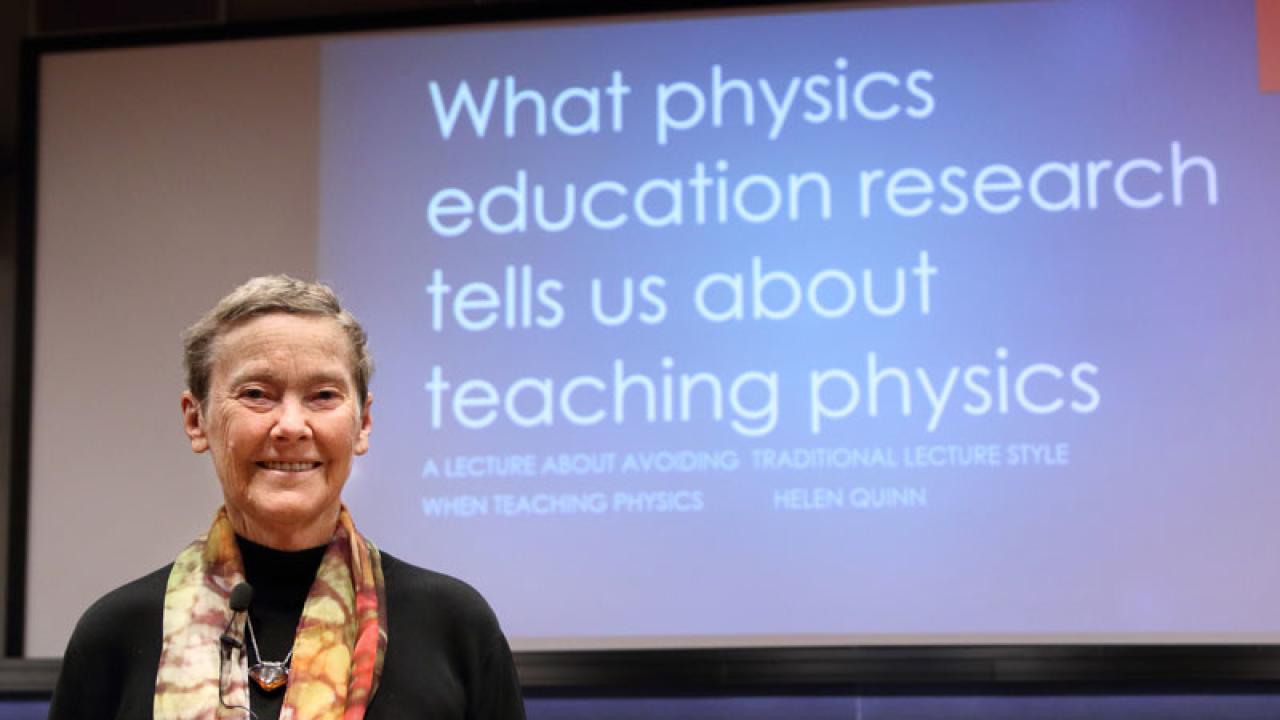
"I am not an education researcher," said Dr. Helen Quinn at the start of her ICTP Colloquium talk on 22 November 2017. A Dirac Medalist and recipient of many other prizes, Quinn is instead an expert in particle physics and the phenomenology of weak interactions. Yet throughout her career and particularly since she retired, Quinn has invested a lot of time and energy into working with education researchers to formulate guidelines for a better way to teach science.
She presented those investigations during her talk titled "What Research on Learning Tells Us About Teaching Physics". The Colloquium is available on ICTP's YouTube channel.
To Quinn, physics education is every physicists' concern: almost every physicist is thrust into the role of physics teacher at some point in their career. Her talk went back to the philosophy of learning, the basic goals of teaching students. "What do we talk about when we talk about learning? I mean having knowledge you can use, not just rote memorization of facts." The researchers Quinn has learned from, including Carl Wieman, repeatedly found that even students doing well on traditional assessments did poorly on conceptual questions. They could solve the equations put in front of them, but they couldn't apply the concepts behind the equations to any other problem.
Both Quinn and researchers in physics education think that understanding the concepts from various angles is a high priority, and that physics education needs new strategies. Active learning, not passive listening, is the key, said Quinn. She described methods of teaching that add up to letting students actively learn, methods including what are commonly known as 'flipped classrooms.'
Humans can only hold about seven concepts in their working memory at one time, Quinn explained. "Really all the lecture is doing is telling them what they have to learn—a big waste of time." In flipped classrooms, new material is presented outside of class time, while class time is reserved for practicing using the new knowledge. Small groups of students tackle questions together, talking through what they understand and don't understand. "The best teaching is facilitated learning," Quinn said.
Turning to science learning for younger students, Quinn and her colleagues on the Board of Science Education at the National Academy of Sciences issued a 2011 Framework for K-12 Science Education, meant to highlight active learning techniques and identify key scientific practices, concepts, and ideas that all students should learn by the time they complete high school. Quinn pointed out that the science and engineering practices listed in this document are equally important for university-level students.
Obtaining, evaluating, and communicating information are key skills that students need to be science-literate citizens. The standards Quinn and her colleagues developed seek to lead students to ask questions, not just to find out what someone else knows, but inquisitive, testable, and quantitative questions that students can find the answers to. Instead of simply obtaining information, Quinn and her colleagues would like students to be able to evaluate and communicate that information, in addition to being able to define problems, develop system models, analyze and interpret data, plan experiments, and engage in arguments from evidence. "Communicating information is key. Scientific communication is a learned skill, and one of the most demanded by employers," Quinn said.
"It's work to teach like this, I know," Quinn said. "Of course, I'm not claiming it's easy to make these changes." She pointed out several key areas where traditional science education falls short: labs are too 'cookbook', too focused on procedures and getting the expected results. Equations are simplified to make the mathematics simple, not to reflect real world examples that students can grasp. Lab reports are useless forms of communication that don't require students to think about the experiments they are doing. "There's more learning when students must struggle with interpretations of data that does not fit the idealized equation they have been given," Quinn reported. "We shouldn’t simply give our students an existing model. Ask them to create their own models. It’s the best way to teach them critical thinking to describe and understand the world around them."
"The goal is not only to prepare a few students to become scientists, but to prepare all of them to become citizens who can think like scientists," Quinn said. "Better results can come from switching to an active learning style of teaching, with not only better conceptual knowledge, but also more students choosing to major in physics and deciding to become physicists."
--- Kelsey Calhoun
















